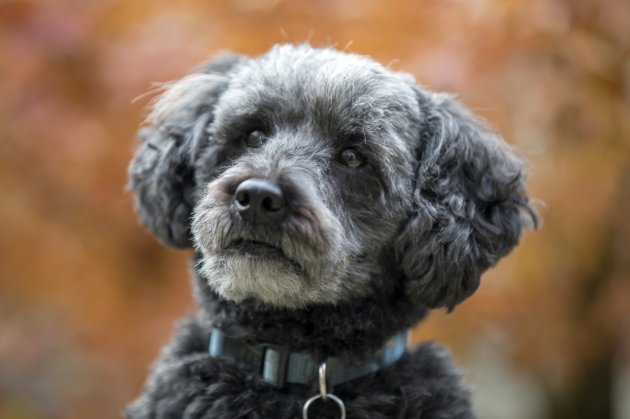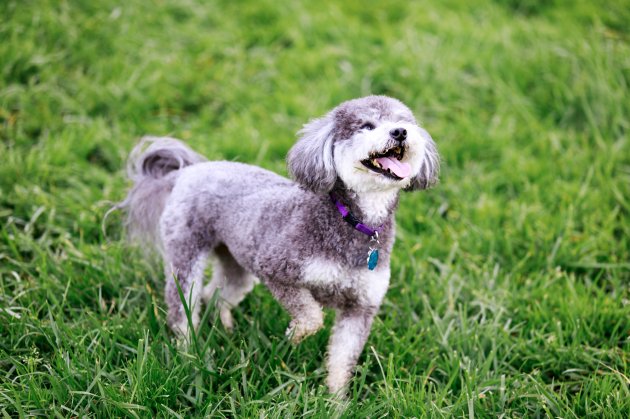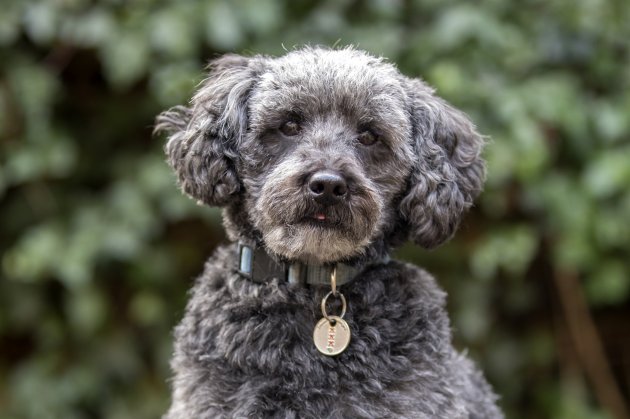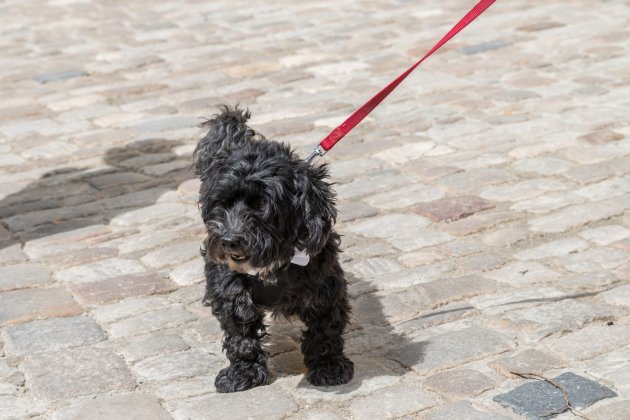Nope, this isn’t a teddy bear! This cutie pie is a Schnoodle, a cross between a Schnauzer and a Poodle. The designer pooch was introduced in the early 1980s when dog fanciers began to grow interested in developing Poodle hybrids. The original goal was to create a low-shedding and low-dander all-around pet. At present, the Schnoodle isn’t recognized by The American Kennel Club, but the designer breed has a growing following nonetheless.
Do you want to know more about the Schnoodle? If you are thinking of getting a fur-baby soon, you might want to check out these Schnoodle facts. Besides, this designer pooch is known for adding zest into the lives of his fur-mama and fur-papa. The only thing more fun than saying “Schnoodle” is having one in your life!

What Does a Schnoodle Look Like?
If Santa Claus gives you a box of Schnoodles for Christmas, you will never know how each pup will turn out. Schnoodles can look different from each other even if they are from the same litter. Being a mix of two breeds, he is open to a range of sizes, coat colors, and textures.
Distinctive Features
If there is one physical attribute consistent to Schnoodles, it is the Schnauzer-like muzzle and long facial hair that gives them a “gentleman’s beard” kind of look. Besides, the Schnauzer influence always tends to be more dominant.
Size
You won’t always find an eensy-weensy Schnoodle. This designer pooch has a significant variance in terms of size, which is attributed to the fact that both its parent breeds come in multiple sizes. The Schnauzer comes in Miniature, Standard, and Giant. Whereas, the Poodle comes in Toy, Miniature, and Standard.
Mating a Miniature Schnauzer with a Toy Poodle creates an itty-bitty Schnoodle. Meanwhile, crossbreeding a Miniature Schnauzer with a Miniature Poodle will lead to a Miniature Schnoodle. If you want a chunkier teddy bear, the breeder should mate a Giant Schnauzer (dam) and a Standard Poodle(sire). Mating a smaller female with a larger male will lead to a life-threatening delivery otherwise.
Avg. height:
- Toy Schnoodles: 25.4 - 30.48 cm (male), 25.4 - 30.48 cm (female)
- Miniature Schnoodles: 30.48 - 38.10 (male), 30.48 - 38.10 cm (female)
- Standard Schnoodles: 38.10 - 66.04 cm (male), 38.10 - 66.04 cm (female)
Avg. weight:
- Toy Schnoodles: 2.72 - 4.53 kg (male), 2.72 - 4.53 kg (female)
- Miniature Schnoodles: 5.89 - 9.07 kg (male), 5.89 - 9.07 kg (female)
- Standard Schnoodles: 9.07 - 34.01 kg (male), 9.07 - 34.01 kg (female)

Coat and Color
As for their coat, the Schnoodle can either inherit more of the Poodle’s silky noodle-like hair or the Schnauzer’s shaggy double coat. Then there are some fur-babies with coats that are a bit of both.
The most common colors observed in Schnoodles are the following:
- Apricot
- Brown
- Black
- Black and tan
- Black and white
- Grey
- Sable
- White
- Phantom (resembling a Dobermann)
What Is it Like to Have a Pet Schnoodle?
You can’t judge a pup’s personality by its looks. You can guess, but your chances of hitting the right notes are as slim as winning the sweepstakes. The best way to get an inkling of what’s in store for your Schnoodle is to understand the lineage of its parent breeds.
Temperament
The Poodle is the Charlie Chaplin of the canine universe. Star-quality runs in his blood! His charms and his great sense of humor make him stand out among the crowd. Poodles are also friendly, but since they can be too accepting of strangers, they make the worst watchdogs. Nevertheless, they are revered healing companions.
The Schnauzer, on the other hand, is intelligent, faithful, and independent. Like a knight in furry armor, he will defend his home regardless of his size. His confidence and nimble wits make him an excellent choice for a variety of roles. But as expected of an intelligent canine, he can be a little stubborn at times.
Now, how your little Schnoodle will turn out depends on the genetic luck of the draw. Aside from the genes he inherits, the amount of socialization your fur-baby receives is also a factor that decides his temperament. What he learns from his littermates can affect his behavior as well.
But as a rule of thumb, the Schnoodle is a naughty but lovable pooch. He will spice up your life and give you tons of giggles! This silly boy loves car rides, especially when he is going to a place he likes. Playtime is a Schnoodle’s favorite part of the day! If the mood takes him, he will transform into a tiny canine version of Loki, the King of Mischief.

Are Schnoodles Good for First-Time Owners?
The Schnoodle is an excellent choice for first-time pet parents because he is genial, adaptable, and eager to please. But there’s a catch! The Schnoodle will wrap you around his paw if he thinks he is brighter than you. Then your bundle of joy might actually turn into a stubborn, spoiled hound. That is why you should train your little Schnoodle the day you bring him home.
Fortunately, a Schnoodle pup can soak up everything you teach him, just like a sponge. With constant training and positive reinforcement, you can prevent or nip negative traits in the bud.
How Do Schnoodles React to Kids?
Schnoodles can be palsy-walsy with small children. These pooches love to play interactive games with them, but they can get a bit boisterous.
Do Schnoodles Get Along with Other Pets?
I don’t think it would be wise to introduce your Schnoodle to a guinea pig or any other pocket pet. These canines are 50% terrier, which means the high prey drive is eminent in their blood. Also, it is best not to keep a cat or any smaller pet that could trigger their need for speed.
Life Span and Health Concerns
Unfortunately, the “Forever Happy Dog” can only live for around 15 years, given that you care for your pooch meticulously. Larger Schnoodles, on the other hand, have a shorter lifespan, and may only live about 10 years max.
The Schnoodle isn’t among the healthiest designer pooches. He is known to suffer from several hereditary health problems, which include the following:
- Addison’s disease
- Bloat
- Cataracts
- Diabetes Mellitus
- Demyelinating Avium Complex (MAC)
- Demyelinating Polyneuropathy
- Elbow dysplasia
- Epilepsy
- Hip dysplasia
- Legg-Calve-Perthes Disease
- Sensitive skin and allergies
- Patellar Luxation
- Progressive retinal atrophy (PRA)
- Von Willebrand’s disease
Living with a senior Schnoodle means taking on a few more responsibilities. Schnoodles who have reached a ripe old age need extensive care, as their immune system weakens over time.

Maintenance
1. Food
The following is just a rough guide. The breeder will usually hand out a feeding schedule and a dog food recommendation. Sticking to the same routine and dog food may help avoid digestive issues, but it is wise to discuss such matters with your vet to ensure your pooch receives the best nutrition.
Serving Recommendations for a Toy Schnoodle puppy
- 2 months old: 63g - 78g
- 3 months old: 71g - 88g
- 4 to 5 months old: 75g - 92g
- 6 months old: 68g - 84g
- 7 months old: 61g - 75g
- 8 months old: 54g - 66g
- 9 to 10 months old: 53g - 66g
Serving Recommendations for a Miniature Schnoodle puppy
- 2 months old: 102g - 135g
- 3 months old: 118g - 160g
- 4 months old: 124g - 171g
- 5 months old: 125g - 174g
- 6 months old: 124g - 173g
- 7 months old: 112g - 156g
- 8 months old: 100g - 138g
- 9 months old: 89g - 122g
- 10 months old: 89g - 121g
Serving Recommendations for a Standard Schnoodle puppy
- 2 months old: 133g - 258g
- 3 months old: 159g - 312g
- 4 months old: 171g - 338g
- 5 months old: 174g - 359g
- 6 months old: 174g - 381g
- 8 months old: 137g - 345g
- 10 months old: 119g - 281g
You can feed a 12-month old puppy adult dog food, but talk to your vet before attempting any changes. As a rough guide, you should feed an adult Schnoodle the following amounts per day:
Serving Recommendations for an Adult Toy Schnoodle
- Dogs weighing 3 kg: 54g - 62g
- Dogs weighing 4 kg: 67g - 78g
- Dogs weighing 4.5 kg: 72g - 84g
Serving Recommendations for an Adult Miniature Schnoodle
- Dogs weighing 6 kg: 92g - 106g
- Dogs weighing 7 kg: 103g to 119g
- Dogs weighing 8 kg: 114g to 132g
- Dogs weighing 9 kg: 125g to 144g
Serving Recommendations for an Adult Standard Schnoodle
- Dogs weighing 9 kg: 129g to 176g
- Dogs weighing 10 kg: 139g to 186g
- Dogs weighing 20 kg: 233g to 307g
- Dogs weighing 30 kg: 295g to 382g
Senior Schnoodles need to eat highly digestible food that doesn’t contain additives and preservatives. Whether you choose to feed your pooch raw food or dry kibble, your vet should be able to supply you with a recipe or a prescription-only product that will meet his needs at this crucial stage of his life. If you choose to feed your pooch commercial dog food, watch out for the small print:
- Protein content should range between 14 – 21% only
- Fat content should not exceed 10%
- Fiber content should not exceed 4%
- Calcium content should range between 0.5 – 0.8% only
- Phosphorous content should be less than 0.7%
- Maximum sodium intake should be 0.4%
2. Grooming
Schnoodles sport different coats. One puppy can get a straight, closer-lying coat, while the other flaunts a longer, wavier coat or a combination of both. Thus, the grooming needs for each Schnoodle can vary depending on which of the parent breed the pup has thrown to.
While the Schnoodle doesn’t shed as much as other canines, they aren’t exempted from regular grooming. Brush your Schnoodle’s beautiful locks every two to three days to prevent matting. Also, trim his nails each week using a nail grinder to make sure you don’t end up nicking the quick. Your Schnoodle will need weekly baths and ear cleaning, too. Brushing your pooch’s teeth will optimize dental health, as well.
Regular trips to the groomer should also be observed, although you can do that at home. Another essential matter is the daily washing of your pet’s face. Tear staining is a common problem for Schnoodles.
3. Exercise
Schnoodles, regardless of their size, are playful and energetic dogs. As such, these lively teddy bears need the right amount of activity to keep them out of trouble. Thirty to sixty minutes of playtime or brisk walking is enough to let off steam; lest, they will tear your house down. You should also combine physical exercise with mental games.
While Toy and Miniature Schnoodles can adapt well to apartment living, Standard Schnoodles may need a fenced backyard to thrive and express themselves. Older Schnoodles, however, don’t require the same amount as a younger pooch, but they still need some workout every now and then to maintain muscle mass and prevent weight gain.
Take Away
The fancy Schnoodle is one of the most talked-about designer pooches. Not only because he has a catchy name, but also because the breed itself is magical! He is brave and loyal as the Schnauzer, and at the same time, he is as bubbly and comical as the Poodle. While he usually resembles a bearded gentleman, you can transform him into a cuddly teddy bear with a few snips. Believe me, no one can resist his charms!
But a word of caution: a Schnoodle demands a hefty boodle for food, doggie toiletries, costumes, vet/groomer trips, and whatnot. While this teddy bear has a lot to offer, he is quite sensitive and needs extra tender loving care. So, are you up for the challenge? If you are willing to commit, we are sure that having a Schnoodle will give you the best time of your life!
Further reading:
- Daily Mail Online. Willie the schnoodle turns globe-trotter to visit 12 countries in five years
- Susanne Saben (Feb 7, 2017) - Schnoodle And Schnoodles: Your Perfect Schnoodle Guide Includes Schnoodle Puppies, Giant Schnoodles, Finding Schnoodle Breeders, Temperament, Miniature Schnoodles, Care, & More!
- Alan Kenworthy (May 15, 2015) - Schnoodles - The Owners Guide from Puppy to Old Age - Choosing, Caring for, Grooming, Health, Training and Understanding Your Schnoodle Dog